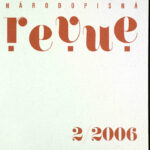Journal of Ethnography 2/2006 is focused upon musical folklore, especially folk songs. Petr Kalina has paid his attention to Ukrainian collections of folk songs (The first notations of Ukrainian musical folklore). Hana Urbancová compares the night watchmen’s songs in Moravia and Slovakia ("The Night- watchmen’s songs" in Moravia and their relation to the Slovakian repertoire). The contribution of Tomáš Šenkyřík deals with Romani songs (Some notes concerning the motifs of Romani songs). Marta Toncrová presents the research of folk songs by children (Folk songs and the youngest generation). Bernard Garaj publishes the text about the entry of the Slovak musical instrument – a shepherds ́ long pipe called fujara – in the UNESCO list of Masterpieces of Oral and Intangible Heritage of Humanity (The past and the present of fujara in the Slovak folk culture).
The Transforming Tradition column brings the source material on folk singers in the region of Chodsko (author Vladimír Baier). The social chronicle remembers anniversaries of some ethnologists: Alexandra Navrátilová (born 1946), Karel Pavlištík (born 1931), Jiří Langer (born 1936), Richard Jeřábek (born 1931) and Josef Jančář (born 1931). Into other sections, the reports of conferences, festivals and reviews of new books have been involved.
The first notations of Ukrainian musical folklore
The essay surveys the first hundred years of collecting the Ukrainian musical folklore in a critical way. Within the results of the path-breaking collector’s attempts we find a lot of imprecision in the folk-song notations. The most collections of that time followed, however, mainly the practical musical aims and they had not any ethnographical ambitions; for all that, one can discover valuable witness of the contemporary musicality therein. The pre-scientific period of collector’s activities is limited by two milestones: the year 1774 on one hand, when the first notated Ukrainian folk songs were printed, and the year 1868 on the other hand, when the musical and folkloristic activity of Mykola Lysenko started. With his methods of folk-song collecting and arrangement, Lysenko broke new ground for the scientific ethnographic approach to Ukrainian musical folklore.
"The Night- watchmen’s songs" in Moravia and their relation to the Slovakian repertoire
The Moravian sources relating to night watchmen’s singing from the published and archive funds that originate previously in the second half of the 19th and the first half of the 20th century, are not very numerous; they enabled, however, to create the basic picture about the Moravian song cycle of a night watchman. The tunes of the songs corresponded both to the informative and protective functions of the guards’ service and to the historical relations to Central European early sacred songs. During reconstruction of this picture, there helped the knowledge gained from a large funds of guards’ songs in Slovakia. Those funds came into being thanks to a questionnaire survey on the initiative of a Czech musicologist D. Orel in the 1930s. The comparison of both repertoire funds confirms the extension of guards’ service along with the songs from the west to the east within Central Europe whereby the cities as centres of larger administrative units became centres of that extension in the past. Whereas those city centres gained recognition for unification of the night watchmen’s repertoire, the traditional rural environment converted that repertoire into many local variations.
Some notes concerning the motifs of Romani songs
The music represents an important element of the Roma identity. In the territory of the Czech Republic, we can see two basic musical expressions: musical folklore of so-called settled Slovak Roma and musical folklore of Vlax Roma. The Romani music is mentioned quiet often, but the text character is described less frequently. The essay brings the attention to the themes, motifs and poetry that are typical for traditional Romany musical production. The following themes have been identified most frequently: 1. poverty, hungry, penury; 2. desolation, loneliness; 3. loss of a family member (most often the mother); 4. mother as dominancy; 5. family, children; 6. love-themes. When studying the texts, we cannot omit a frequency of certain words that we meet in the Romany production. There are especially God (o Del), children, (mire čhave, čhavore), mother (e Daj), furthermore also heart (o jilo), tears (o apsa, apsora) etc. It is interesting that we cannot observe a more conspicuous line between the traditional and present production, as to the texts.
Folk songs and the youngest generation
The essay publishes the results of a research on folk-song knowledge at the youngest generation. The research was done by means of questionnaires in Brno, with the pupils of a primary school and the students of the Masaryk's University. Altogether, there were completed 286 questionnaires. Among 140 songs, the informants should tick off those songs that they knew. The songs were chosen in the textbooks for musical teaching. From the questionnaire, high knowledge of carols and children’s songs resulted; the children meet those songs always in their families or in the nursery schools. At the end of the 1940s, the children sang the same songs, as they mentioned in a questionnaire that was a part of a sociological research in the elementary and secondary schools. It concerns e.g. the songs Holka modrooká, Jede, jede poštovský panáček, Pásla ovečky, Travička zelená etc. The group of this age showed little knowledge of the songs from Slovácko (Moravian Slovakia), in contrary to the common repertoire of folk songs by the adults. Here we have summarized the results of the first probe, the research will continue.
The past and the present of fujara in the Slovak folk culture
Today for the Slovak folk music there is no other instrument with such a big significance as fujara is. As an originally three- -hole flute of shepherds in central parts of Slovakia since the half of the 19th century it has became a symbol of all the Slovak folk musical instruments. In the 20th century fujara has been known, accepted and presented as an important attribute of the Slovak identity and a symbol of the Slovak nation as well. On the other hand fujara has found its reflection in specific processes and changes concerning the morphology, decoration, social status of fujara makers and players as well as its spreading and new ways of its musical usage.



